B1.1 Read and represent whole numbers up to and including one million, using appropriate tools and strategies, and describe various ways they are used in everyday life.
Skill: Reading Whole Numbers up to a Million
Reading numbers involves interpreting them as a quantity when they are expressed in words, in standard notation, or in expanded notation.
Source: Ontario Curriculum, Mathematics Curriculum, Grades 1-8, Ontario Ministry of Education, 2020..
The Base Ten System
The base ten number system commonly used in many countries uses 10 different symbols, namely the digits 0, 1, 2, 3, 4, 5, 6, 7, 8 and 9. It is a place-based or positional system since the symbols are given different values depending on their position or placement in a number. For example, the number 2 has a value of 2 ones in the number 356 742, while it has a value of 20 000 ones in the number 623 487. Understanding the relationship between the value of digits and their position in a number is essential to the development of number sense.
In the primary grades, students develop an understanding of the relationships among the place values of ones, tens, and hundreds. However, in the Junior and Intermediate Divisions, they do not automatically transfer this understanding to larger numbers. For this reason, teachers must ensure that students understand that the value of any position in a number is always 10 times larger than the value of the position immediately to the right, and 10 times smaller than the value of the position immediately to the left. It is also important to examine the hundredfold or thousandfold relationships between place values in order to develop students' deep number sense, including large number sense.
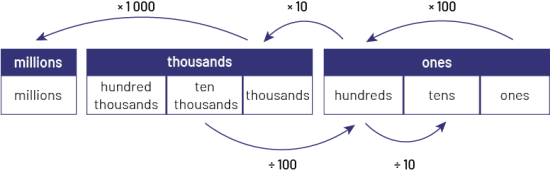
Students should also recognize, for example, that one (1) ten thousand represents a grouping of 100 hundreds, a grouping of 1000 tens, or even a grouping of 10 000 ones. These groupings allow students to recognize equivalent representations of numbers (for example, 2 534 is equal to 25 hundreds and 34 ones).
Source: translated from Guide d'enseignement efficace des mathématiques de la 4e à la 6e année, Numération et sens du nombre, Fascicule 1, Nombres naturels, p 44-45.
It is important that students understand that a zero in a column indicates that there are no groups of that size in the number. It serves as a placeholder, holding the other digits in their correct “place”.
Source: Ontario Curriculum, Mathematics Curriculum, Grades 1-8, Ontario Ministry of Education, 2020..
Number is an abstract representation of a very complex concept. For this reason, the relationship between the way a number is named and the quantity it represents is not obvious to students. Many adults mistakenly believe that if students can count, they understand the meaning of each number. However, a student may well be able to read and name a number, for example, two hundred and fifty-eight thousand, without really having a sense of the quantity it expresses.
Teachers need to help students make connections between the base ten number system and how to name and write numbers.
Source: translated from Guide d'enseignement efficace des mathématiques de la 4e à la 6e année, Numération et sens du nombre, Fascicule 1, Nombres naturels, p. 65.
One strategy that promotes the association of the number with the quantity it represents is to name the number by emphasizing the place value of each of the digits that make up the number (for example, instead of reading the number 762 098 as seven hundred sixty-two thousand ninety-eight, students can say 7 hundred of a thousands, 6 ten thousands, 2 thousands, 9 tens and 8 ones) or certain groupings (for example, 76 ten thousands and 2098 ones).
Source: translated from Guide d'enseignement efficace des mathématiques de la 4e à la 6e année, Numération et sens du nombre, Fascicule 1, Nombres naturels, p. 70.
Mental Representation
The mental representation of a quantity is the image that comes to mind when thinking of a number. When students hear and read a number, they need to "see" the quantity that the number represents and understand the "how much" it represents.
It is therefore important that students develop mental representations of different numbers in different contexts. Take, for example, the number "200 000," which can be mentally represented by 20 grids of 10 000 or by 10 times the number of seats found in a lecture hall.
It is important for students to develop a variety of mental representations of numbers. These visualizations may simply represent quantities. For example, the "how many" of 100 000 can generate a mental representation of 100 grids of 1000. However, the presence of units in a situation may promote a different and more precise mental representation that would be related to a given situation. For example, students may visualize that 100 000 people represent 100 cars parked in 1000 parking lots in the city or 200 schools with 500 students.
In addition, if the context suggests it, students can look critically at the quantity (for example, determine whether it is "a lot" or "a little"). The mental representation will then be coloured by the context. For example, the mental representation of 100 people at a family party is not the same as 100 people in a crowd at a field hockey game. The various mental representations are all valid; they depend primarily on the context of the situation and the students' sense of number. The mental representation remains personal, but the ease with which an individual can visualize numbers is an indicator of their number sense.
In order to develop mental representations, students use different strategies that respond to various situations and needs. With very small numbers, it is possible for them to subitize, that is, to quantify the elements of a small set of objects without counting each element. To recognize larger quantities, students will use other strategies. For example, counting each pea in a package of peas can be laborious, so grouping can be used.
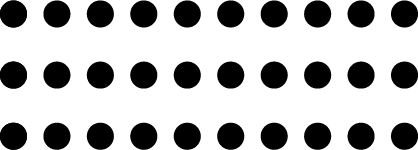
After counting out 10 peas, they can see that there are three equal sets for a total of 30 peas. In this case, the counting to 10 strategy is combined with the subitizing (three sets of 10). As they progress, students will increasingly use grouping to understand quantity. Thus, students will create mental representations by visualizing equal groupings, for example, visualizing 30 as 3 sets of 10 peas.
Making mental representations of large numbers can not be done by visualizing the elements individually. However, it can be created by using cues that are related to a large quantity (for example, recognizing that 100 000 people is about five times the number of spectators in an amphitheater with 20 000 seats).
Source: translated from Guide d'enseignement efficace des mathématiques de la 4e à la 6e année, Numération et sens du nombre, Fascicule 1, Nombres naturels, p 29-31.
Benchmarks
In general, a benchmark is a reference. As part of the development of number sense, the use of benchmarks promotes mental representations, which facilitates the understanding of number and the notion of “how much”. Benchmarks, without which it is difficult to understand quantity, are numbers or quantities that can be easily represented mentally since they have already been seen and manipulated. Students will have difficulty understanding quantity if they do not use benchmarks. For example, when reading a book of world records, students see impressive numbers, but often do not have a true understanding of the size of these numbers unless they establish links between these numbers and meaningful benchmarks. Such is the case of a student who reads the following excerpt:
The Heaviest Newborn
On January 19, 1879, the Canadian Anna Bates [...] gave birth at home [...] to a baby boy who weighed 10.8 kg and measured 76 cm.
(Guinness World Records, 2005, p. 22)
A student may respond to this fact and finds it extraordinary without relating the quantity 10.8 kg to a benchmark. This fact is extraordinary because it is a "world record", but does the student grasp that this baby is probably more than double their own birth weight?
Source: translated from Guide d'enseignement efficace des mathématiques de la 4e à la 6e année, Numération et sens du nombre, Fascicule 1, Nombres naturels, p. 33.
As a result of experiences (for example, studying money, counting by intervals of 25 000, 50 000 and 100 000) and learning (for example, internalizing relationships such as \(4\; \times 25\;000\; = 100\;000\), \(100\;000\; = \;2\; \times \;50\;000\), \(2\; \times \; 2\; \times \;25\;000\; = \;100\;000\)), numbers such as 25 000, 50 000 or 100 000 can become benchmarks. Thus, 32 000 can be understood as 25 000 plus 7000 or 25 000 plus 5000 plus 2000, and the number 125 000 can be quickly associated with 5 groups of 25 000.
Although the majority of students entering Grade 6 know how to read and symbolically write numbers up to 100 000, they don't necessarily understand the quantity represented by these large numbers. By creating cues and visualizing groupings, they will develop a better understanding of the concept of quantity represented by large numbers.
Benchmark numbers are particularly useful for understanding large numbers, since it is usually impossible to recognize these quantities globally or to grasp them by counting. Students need to get a sense of them by comparing them with a benchmark number. For example, the school just received 200 000 sheets for photocopying. Should the custodian ask for help carrying them? In order for students to truly understand the situation and the quantity involved, they need to create a mental image of what 200 000 sheets might represent. Using a package of 500 sheets as a guide, students can imagine this quantity and apply the proportionality relationship to deduce that 2 packages contain 1000 sheets. Therefore, 100 000 sheets would be 100 times as many packages, or 200 packages of sheets. We can even recognize that 40 packages are equivalent to 2 boxes of paper. The mental representation of the space occupied by these 200 000 sheets then becomes possible. The answer to the original question, whether the custodian should ask for help in carrying the sheets, can then be debated with full knowledge.
Students should develop their own personalized benchmarks, depending on the context and the numbers being dealt with. There is no list of benchmarks. They are personal and come from experiences, making them meaningful and easier to use. However, real-life situations provide the teacher with sufficient opportunities to draw their students' attention to quantity and the creation of benchmarks.
Source: translated from Guide d'enseignement efficace des mathématiques de la 4e à la 6e année, Numération et sens du nombre, Fascicule 1, Nombres naturels, p 34-35.
Approximation
Numbers represent quantities with a high degree of accuracy. This is because they provide a precision that terms like "more", "some", "many" and "few" do not. However, they can also be used to show the relative size of that quantity. In this case, the number is used to approximate the quantity (for example., about "200 people were at the party" does not mean that there were exactly 200). In general, the approximation is a magnitude that is close enough to a known (rounding) or unknown (estimation) magnitude.
The terms "estimating" and "rounding" are often, and incorrectly used interchangeably. The fundamental difference between these two concepts lies in how the number is determined. Estimating uses the relationship between an unknown quantity and prior knowledge, usually in the form of benchmark numbers. Rounding, on the other hand, uses the relationship between a known number (precise or approximate) and its relative proximity to other numbers. Generally, estimating and rounding are used to visualize the quantity in question and to get a sense of the size of the quantity. The following table demonstrates this distinction.
| Rounding a Number | Estimating a Quantity | |
|---|---|---|
| Definition | Replace a number with a value appropriate to the situation, following some predefined or personal criteria. | To estimate a quantity. |
| Example | If the list price of a new car is $18 753, we can say that it costs around $19 000. | Walking through a parking lot, you notice a car and estimate its price at $20 000. |
| Explanation | The actual price (known number) has been rounded to the nearest thousand. | The price is not based on any specific information received, but on prior knowledge. |
Source: translated from Guide d'enseignement efficace des mathématiques de la 4e à la 6e année, Numération et sens du nombre, Fascicule 1, Nombres naturels, p 35-36.
Skill: Representing Numbers in Different Ways
Students need to learn to represent numbers in a variety of ways and to recognize them in their multiple representations. These skills help them make connections between a number, its representation, and the quantity it represents. It is therefore essential that students be exposed to different representations of numbers and to a variety of contexts that lead them to represent a number in each of the representations shown in the diagram below, as well as to move from one representation to another.
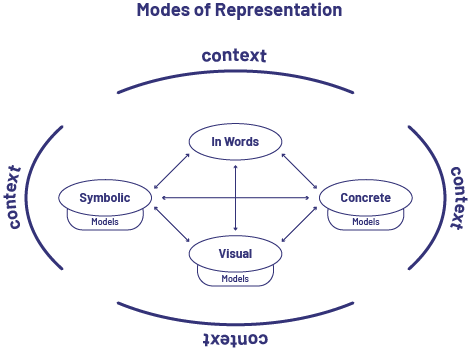
Teachers need to be aware of the order in which they should introduce these four modes of representation with students. Baroody and Coslick (1998) suggest that a new concept should be presented in a real, meaningful context so that students can first create representations using words, followed by concrete, visual (semi-concrete) representations. Only when they have developed some understanding of the concept can they move on to its symbolic representation. Students need to be able to make connections between representations and move easily from one representation to another.
Source: translated from Guide d'enseignement efficace des mathématiques de la 4e à la 6e année, Numération et sens du nombre, Fascicule 1, Nombres naturels, p. 64-65.
Representations Using Words
In the junior grades, students learn to read and write numbers up to a million. The challenges of writing numbers in words should not be underestimated. To help students overcome these challenges, teachers should include numbers on the word wall and build anchor charts with them.
Concrete Representations
Using manipulatives (such as a place value mat and counters) to represent numbers helps students develop number sense. A word of caution is in order when using manipulatives. It is important to recognize that these materials represent a mathematical concept, not the concept itself; for example, a counter is not a hundred thousand, but it represents a hundred thousand ones.
The danger is that students will use the manipulative mechanically without making the connections to the underlying mathematical concepts. For this reason, teachers must ensure that there is real learning and not just blind use of the model. For example, it is easy for students to fill in the blanks in the sentence below the picture by looking at the place value mat.

The representation is ____ hundreds of thousands, ____ tens of thousands, ____ thousands, ____ hundreds, ____ tens and ____ ones.
But do they understand that there are also nine hundred thirty-one thousand seven hundred twenty-four ones on the mat and that this is a representation of the number 931 724? It is important to ask students to explain in different ways what is represented. For example, 931 724 can be thought of as 931 thousands and 724 ones or 93 172 tens and 4 ones. Another way to check understanding is to ask the students, for example, how many ten thousands are there in 931 727? Many students will tend to say that there are 3 of them. It is important to clarify that the number in the tens of thousands position is a "3", but that the number 931 172 is composed of 93 ten thousands (\(93 \; {groups} \;\;\ of \;\; 10000 \;\;units,\;\; which\;\; is\;\; 930000\)). We can “see” these 93 ten thousands by converting the hundred thousands into ten thousands. That being said, one counter representing one hundred thousand is equivalent to 10 ten thousands counters, as shown in the illustration below. So 9 hundred thousands is equal to 90 ten thousands. We can then add the 3 ten thousands to the 90 ten thousands for a total of 93 ten thousands.
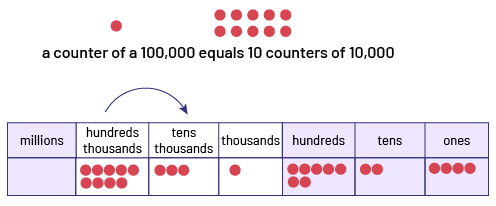
Using the place value mat, we notice that even though numbers are written from left to right, they are formed from right to left: ones grouped together form tens, tens grouped together form hundreds, and so on.
The choice of materials available to students can also make a difference in their level of understanding different concepts. There are a variety of materials on the market to represent numbers: marbles, nesting cubes, or any other object that can be used to count. Some of these materials clearly and concretely represent the magnitude relationship between ones, tens, hundreds, etc. However, with other materials, this relationship is represented in a more abstract way. For example, on an abacus, a place value flip chart or a horizontal abacus, the grouping is represented according to the position of the digit from left to right, as in symbolic number writing.
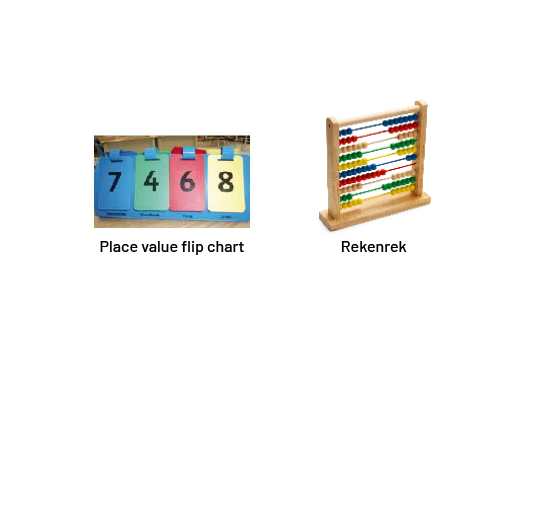
By exposing students to a variety of manipulatives, teachers can help them develop a better understanding of numbers.
Source: translated from Guide d'enseignement efficace des mathématiques de la 4e à la 6e année, Numération et sens du nombre, Fascicule 1, Nombres naturels, p 66-68.
Visual (Semi-Concrete) Representations
Students can also represent numbers using visual or semi-concrete materials (for example, sketch, hundreds chart, number line).
Sketch: A number can be represented by sketches that illustrate certain groupings. For example, the number 376 000 can be illustrated in groups of 50 000 as follows:

Number Charts: The hundreds chart is widely used in the primary grades. Although more difficult to manipulate, a grid of 1 000 or even 10 000 can help students in the junior grades to better understand numbers by providing them with tools to compare and contrast.
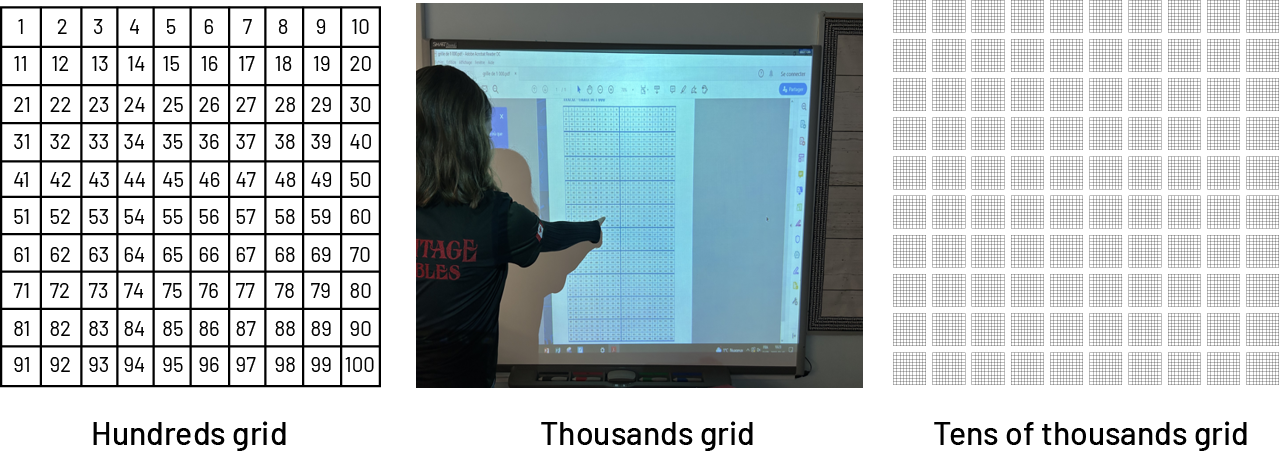
Number Lines: In the primary grades, students use and construct number lines to skip count or to identify the number of tens in a number. In the junior grades, the use and construction of a variety of number lines allows students to represent large numbers and recognize the relationships between them. Examples of number lines showing the number 455 736 include the following:
- number line with a scale of 100 000;

- number line that does not start at 0, with a scale of 50 000;

- an open number line (not scaled) on which numbers are placed in relation to each other;

- a vertical number line with numbers in ascending order upward and has applications in other areas, including Spatial Sense/Measurement (for example, thermometer) and Data (for example, y-axis).

In the junior grades, the use of ten frames and the grouping principle of making groups of 10 is another way to represent the value of the digits that make up large numbers.

Symbolic Representation
Numbers are represented symbolically by the digits that make them up. They are written from left to right in 3-digit periods that make up the trillions, billions, millions, thousands and ones. Each of the periods includes hundreds (h), tens (t) and ones (o).

Note: In English as well as in French, numbers are written by adding a space between the 3-digit increments (for example, 13 567 232).
The writing of large numbers requires a good mastery of place value, otherwise the student who is asked to write symbolically "one hundred thirty-one thousand two hundred thirteen" could write 100 31 000 200 13 or 131 000 200 13 or 131 200 13 or 131 213. It also requires an understanding of the role of the zero as a placeholder indicating the absence of a quantity in one of the positions.
Here is an example of a reasoning that students could use to symbolically represent a large number such as nine hundred twenty-six thousand four hundred:
- nine hundred and twenty-six thousand is represented by a 9, 2 and 6 in the thousands period.
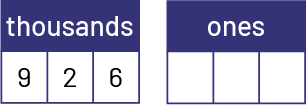
- four hundred is represented by a 4 in the hundreds position of the ones period. Since there is no indication for the tens and ones position, a 0 must be added to fill each of these positions.
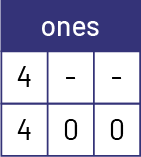
- then, nine hundred and twenty-six thousand four hundred written symbolically gives 926 400.

A number can be represented in different ways using mathematical symbols, either by respecting the value of the position of each digit (\(100\;\;236\)is equal to \(100\;\;000\; + \;200\;+ \;30\; + \;6\)). This is achieved either through some place values (100 236 is equal to 1002 hundreds and 36 ones) or by performing different operations (100 236 equals \(100\;\;000\; + \;236\) or \(100\;\;240\; - \;4\) or \(100\;\;200\; + \;36\) or \(100\;\;000\; + \;100\; + \;100\; + \;15\; + \;15\; + \;6\)). In fact, there are infinite ways to represent a number, each allowing students to give themselves another way of interpreting it and understanding its meaning.
Source: adapted and translated from Guide d'enseignement efficace des mathématiques de la 4e à la 6e année, Numération et sens du nombre, Fascicule 1, Nombres naturels, p. 64-71.
In the junior grades, the use of tables is another way to represent the value of the numbers that make up large numbers.
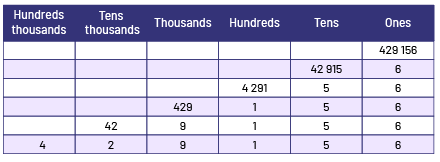
Equality
A number is represented symbolically using digits. For example, the number eight hundred fifty-five thousand two hundred fifty-six written symbolically gives 855 256. It can also be represented using various numerical expressions. For example, the representation \(800\;\;000 + \;50\;\;000 + \;5000 + \;200 + \;50 + \;6\) makes it possible to recognize 855 256 according to the place value of the digits that make it up. There are many other ways to decompose or represent this number.
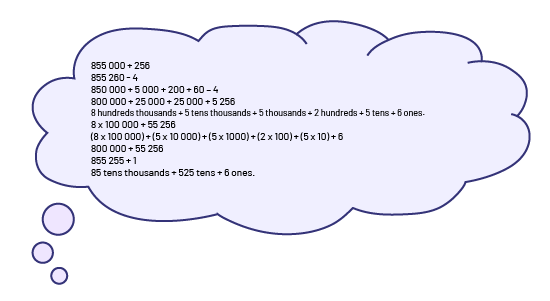
Exploring multiple representations of a number supports students in developing a better understanding of that number. In problem-solving situations, students must learn to choose the most appropriate representation for the context and intent. Some examples include:
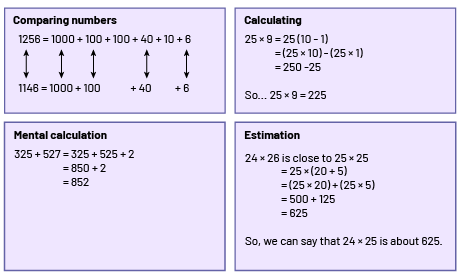
Source: translated from Guide d'enseignement efficace des mathématiques de la 4e à la 6e année, Numération et sens du nombre, Fascicule 1, Nombres naturels, p. 48-49.
The expanded form represents the value of each digit separately, as an expression. Using expanded form, 7287 is written as \(7000\; + \;200\; + \;80\; + \;7 = 7287\).
Comparing and relating quantities supports students to understand the relative size of a number, or "how much" it is.
Source: Ontario Curriculum, Mathematics Curriculum, Grades 1-8, 2020, Ontario Ministry of Education.
Relationships in Ordering and Comparing
The ability to recognize order relationships is acquired by comparing numbers, placing them in ascending and descending order, counting forward and backwards and analyzing the relative proximity of two numbers.
In the intermediate grades, students recognize the order relationship between numbers by comparing them. They can describe the relationship by stating, for example, that 12 273 is smaller than 23 942. Examples of strategies that students can use to compare large numbers include:
Comparison of the Numbers 23 942 and 12 273
Students can recognize that 23 942 is larger than 12 273:
- by targeting a significant place value in each number (note that 23 000 is larger than 12 000);
- by visualizing large quantities (visualize 23 groupings of 1000 and 12 groupings of 1000);

- by locating the numbers on a number line (the number 23 942 is located to the right of the number 12 273 meaning that it is the greater of the two);

- by comparing the numbers in the various positions from the left (2 represents 20 000 while 1 represents 10 000);

- By comparing the place values expressed using the expanded form
\(23\;\;942\; = \;2\; \times \;10\;\;000\; + \;3\; \times \;1000\; + \;9\; \times \; 100\; + \;4\; \times \;10\; + \;2\; \times \;1\)
↓
\(12\;\;273\; = \;1\; \times \;10\;\;000\; + \;2\; \times \;1000\; + \;2\; \times \; 100\; + \;7\; \times \;10\; + \;3\; \times \;1\)
To help students develop the skill of recognizing order relationships among large numbers, teachers can, starting with a given number, ask them to count up by 1 (for example., 12 998, 12 999, 13 000, 13 001…) or up by intervals (for example, 32 200, 32 400, 32 600…) and count down by 1 (for example, 26 271, 26 270, 26 269…) or by intervals (for example, 45 650, 45 600, 45 550…).
These activities help students recognize that when counting by 1s or intervals, any named number is greater than those before it and less than those after it, whereas when counting backwards by 1s or intervals, any named number is less than those before it and greater than those after it. While these relationships may seem obvious to adults, students often get them wrong because they do not consider the concept of grouping. When asked, for example, what number precedes 300, many students tend to spontaneously answer 399 because their attention is focused on the two 0's; they know that a number ending in two 0s is always preceded by a number ending in two 9's, and they forget to consider regrouping by hundreds. In contrast, when the same problem is posed in context, students give more thoughtful responses; for example, in a situation where a person has 300 field hockey cards and loses one, students will readily respond that they have 299 cards left.
Once students have mastered the relationships "greater than" and "less than," they need to learn to make these relationships more specific by drawing on their understanding of quantity. They then use expressions such as close to, about, the same as, much more than , and a little less than. For example, students may say that the population of a village of 15 239 is about 15 000; that 304 is a little more than 300; that 12 894 is a little less than 13 000; that 32 523 is about a hundred more than 32 432; and that 620 and 618 are closer together than 630 and 680.
Being able to specify number order relationships becomes important when students use numbers in problem solving, rounding, estimating and comparing. The following activity allows students to demonstrate this skill.
Draw a number line on the board to represent any interval (for example, 1000 to 2000). Place some letters (for example, A, B, C, D) in this interval as shown below.

Ask a few students to come and locate some numbers on the line (for example, 1873, 1332, 1167). Then ask them to describe the ordering relationships that exist between the numbers and the letters.
For example, students might say:
- that 1167 lies between A and B;
- that the letters B and C are between 1167 and 1332;
- that the number 1873 is closer to 2000 than to the letter D;
- that the letter B seems to be more in the centre of the interval between 1000 and 1500 than is the letter C.
Source: translated from Guide d'enseignement efficace des mathématiques de la 4e à la 6e année, Numération et sens du nombre, Fascicule 1, Nombres naturels, p 45-48.
Skill: Describing the Ways in Which Numbers are Used in Everyday Life
Context is all the information surrounding a given situation. This information helps to identify the situation in which the quantities are used and facilitates the exercise of a critical eye on the numbers in question. Context facilitates making connections between numbers, mathematical concepts and the mathematical world. For all these reasons, the exploration of mathematics in problem-solving situations is important.
What does 214 725 mean exactly? We are talking about 214 725 "what"? In short, a number without context has little meaning. Therefore, it must be accompanied by units if it is to be understood. Students in the primary grades have already done number activities in a variety of contexts using different units. In the junior grades, this contextualization needs to be maintained in order to develop a sense of quantity with numbers in the thousands and millions.
An important step is to support students in understanding that the same number represents the same quantity even though the contexts are different. The number is the symbolic representation of the quantity. If there are 1 000 000 people, apples, or buildings, the quantity that is one million does not change. Yet, if students are asked if they think there are more apples than buildings, many students are likely to answer that there are more buildings than apples. They have focused on the space occupied by the objects rather than the quantity of objects (1 000 000).
Students should also recognize that depending on the context of the given situation, different interpretations can be made of the same quantity. For example, for young people, $1 000 000 may represent a lot of money. However, in context, the meaning of the number invites nuance: it is a lot for the price of a house, but not much for the price of a residential building. The context changes, but the quantity remains the same. Similarly, 1 000 000 blocks of wood is a lot of blocks, whereas 1 000 000 grains of sand is the same as a 2 m3 sandbox. Or, students may think that 171 575 is not a large number, but when you add in the fact that this number represents the total population of Prince Edward Island in September 2022, it takes on a whole new value. These simple, concrete examples encourage students to think about and critically analyze quantities.
In the Junior and Intermediate Divisions, understanding numbers in context becomes increasingly important. Students need to begin to make critical judgments about quantities and to be discerning about numbers. Learning activities should therefore help students develop other skills, such as recognizing the reasonableness of a given number, recognizing that it is an exact value, or recognizing that it is an approximate number resulting from estimation or even rounding. The development of these skills can be initiated by having class discussions about the meaning of numbers from newspapers and discussing their actual meaning and relevance.
The context also allows us to recognize that the same number does not always have the same meaning. The common interpretation associates them with a quantity or cardinal number. However, some numbers do not represent quantities, but rather a position, as is the case of ordinal numbers. For example, in a marathon, the runner who is in 11 582nd does not represent 11 582 people, but rather is the 11 582nd person to cross the finish line. Numbers can also be used to label or identify as is the case with social insurance numbers, bar codes, license plates and addresses.
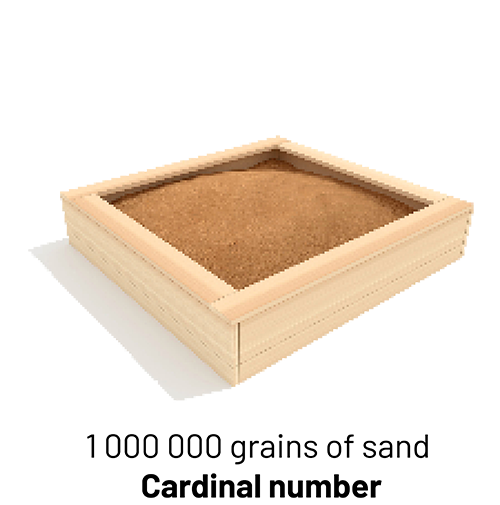

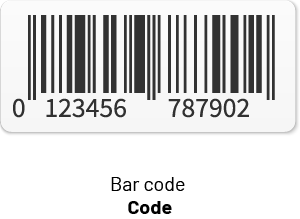
Source: translated from Guide d'enseignement efficace des mathématiques de la 4e à la 6e année, Numération et sens du nombre, Fascicule 1, Nombres naturels, p 31-32.
Knowledge: Whole Numbers
Whole numbers are all positive integers, including 0.
For example: 0, 134, 5 826, 56 023, 674 150, 1 000 000, …
There is an infinity of whole numbers.
Whole Numbers in Our Base Ten System
Our base ten system is based on groups of 10.
- The ones are grouped into groups of 10 and form the tens.
- The tens are grouped into groups of 10 and form the hundreds, and so on.
Source: translated from L'@telier - Online Educational Resources (atelier.on.ca).
